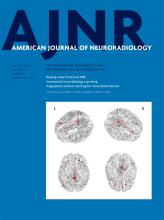Research ArticleAdult Brain
Open Access
Morphology-Specific Discrimination between MS White Matter Lesions and Benign White Matter Hyperintensities Using Ultra-High-Field MRI
Z. Hosseini, J. Matusinec, D.A. Rudko, J. Liu, B.Y.M. Kwan, F. Salehi, M. Sharma, M. Kremenchutzky, R.S. Menon and M. Drangova
American Journal of Neuroradiology August 2018, 39 (8) 1473-1479; DOI: https://doi.org/10.3174/ajnr.A5705
Z. Hosseini
aFrom the Biomedical Engineering Graduate Program (Z.H., R.S.M., M.D.)
bImaging Research Laboratories (Z.H., J.L., R.S.M., M.D.), Robarts Research Institute
J. Matusinec
cDepartments of Medicine (J.M.)
D.A. Rudko
fDepartment of Neurology and Neurosurgery (D.A.R.), McConnell Brain Imaging Centre, Montreal Neurological Institute
gDepartment of Biomedical Engineering (D.A.R.), McGill University, Montreal, Quebec, Canada
J. Liu
bImaging Research Laboratories (Z.H., J.L., R.S.M., M.D.), Robarts Research Institute
B.Y.M. Kwan
dMedical Imaging (B.Y.M.K., F.S., M.S.)
F. Salehi
dMedical Imaging (B.Y.M.K., F.S., M.S.)
M. Sharma
dMedical Imaging (B.Y.M.K., F.S., M.S.)
hDepartment of Clinical Neurological Sciences (M.S., M.K.), Western University and London Health Sciences Centre, London, Ontario, Canada.
M. Kremenchutzky
hDepartment of Clinical Neurological Sciences (M.S., M.K.), Western University and London Health Sciences Centre, London, Ontario, Canada.
R.S. Menon
aFrom the Biomedical Engineering Graduate Program (Z.H., R.S.M., M.D.)
bImaging Research Laboratories (Z.H., J.L., R.S.M., M.D.), Robarts Research Institute
eMedical Biophysics (R.S.M., M.D.), Schulich School of Medicine and Dentistry; Western University, London, Ontario, Canada
M. Drangova
aFrom the Biomedical Engineering Graduate Program (Z.H., R.S.M., M.D.)
bImaging Research Laboratories (Z.H., J.L., R.S.M., M.D.), Robarts Research Institute
eMedical Biophysics (R.S.M., M.D.), Schulich School of Medicine and Dentistry; Western University, London, Ontario, Canada

References
- 1.↵
- Polman CH,
- Reingold SC,
- Banwell B, et al
- 2.↵
- 3.↵
- Miller AE,
- Wolinsky JS,
- Kappos L, et al
- 4.↵
- Comi G,
- De Stefano N,
- Freedman MS, et al
- 5.↵
- Kappos L,
- Freedman MS,
- Polman CH, et al
- 6.↵
- Hannoun S,
- Heidelberg D,
- Hourani R, et al
- 7.↵
- Tan L,
- van Schijndel RA,
- Pouwels PJ, et al
- 8.↵
- 9.↵
- 10.↵
- Mistry N,
- Dixon J,
- Tallantyre E, et al
- 11.↵
- Cortese R,
- Magnollay L,
- Tur C, et al
- 12.↵
- 13.↵
- Sati P,
- Oh J,
- Constable RT, et al
- 14.↵
- 15.↵
- Tallantyre EC,
- Dixon JE,
- Donaldson I, et al
- 16.↵
- 17.↵
- 18.↵
- 19.↵
- 20.↵
- 21.↵
- 22.↵
- Jenkinson M,
- Beckmann CF,
- Behrens TE, et al
- 23.↵
- Smith SM
- 24.↵
- Jenkinson M,
- Bannister P,
- Brady M, et al
- 25.↵
- Zhang Y,
- Brady M,
- Smith S
- 26.↵
- Rosset A,
- Spadola L,
- Ratib O
- 27.↵
- 28.↵
- Fazekas F,
- Offenbacher H,
- Fuchs S, et al
- 29.↵
- 30.↵
- Labate A,
- Gambardella A,
- Aguglia U, et al
- 31.↵
- Vernooij MW,
- Ikram MA,
- Tanghe HL, et al
- 32.↵
- Sati P,
- George IC,
- Shea CD, et al
In this issue
American Journal of Neuroradiology
Vol. 39, Issue 8
1 Aug 2018
Advertisement
Z. Hosseini, J. Matusinec, D.A. Rudko, J. Liu, B.Y.M. Kwan, F. Salehi, M. Sharma, M. Kremenchutzky, R.S. Menon, M. Drangova
Morphology-Specific Discrimination between MS White Matter Lesions and Benign White Matter Hyperintensities Using Ultra-High-Field MRI
American Journal of Neuroradiology Aug 2018, 39 (8) 1473-1479; DOI: 10.3174/ajnr.A5705
0 Responses
Morphology-Specific Discrimination between MS White Matter Lesions and Benign White Matter Hyperintensities Using Ultra-High-Field MRI
Z. Hosseini, J. Matusinec, D.A. Rudko, J. Liu, B.Y.M. Kwan, F. Salehi, M. Sharma, M. Kremenchutzky, R.S. Menon, M. Drangova
American Journal of Neuroradiology Aug 2018, 39 (8) 1473-1479; DOI: 10.3174/ajnr.A5705
Jump to section
Related Articles
Cited By...
- Central Vein Sign in Multiple Sclerosis: A Comparison Study of the Diagnostic Performance of 3T versus 7T MRI
- Value of 3T Susceptibility-Weighted Imaging in the Diagnosis of Multiple Sclerosis
- The Central Vein Sign in Radiologically Isolated Syndrome
- Gadolinium-Enhanced Susceptibility-Weighted Imaging in Multiple Sclerosis: Optimizing the Recognition of Active Plaques for Different MR Imaging Sequences
This article has not yet been cited by articles in journals that are participating in Crossref Cited-by Linking.
More in this TOC Section
Similar Articles
Advertisement











